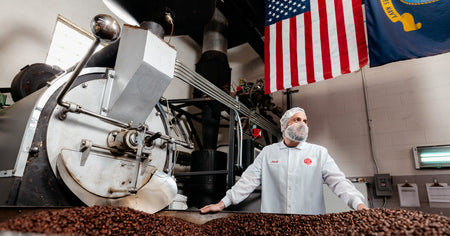November 18, 2020
If you break into a few Italian houses and open their cupboards… well, you’ll probably get yourself in trouble, but you’ll also find a moka pot in most of them!
Invented in 1933, these iconic stovetop espresso makers are quick, practical and travel-friendly, but sometimes get a bad reputation because of over-extraction.
Don't worry about that! Here’s how to make coffee in a moka pot without incurring in the burnt taste that might have put you off that time your friend tried to brew it.
How to make coffee in a moka pot & brew the perfect espresso

Have the right grounds
For the best results, grind some fresh coffee beans with a burr grinder (around 20-22g), and aim for a fine or medium-fine grind. Don’t go as fine as you would for an espresso machine: it could clog up your moka pot’s filter and build up too much pressure. Add your grounds to the filter and tap them to ensure they’re even, but without tamping them.
Careful with the water!
Add either cold or preheated water—the latter can speed up the process and avoid a metallic taste—to the bottom chamber. No matter how sleepy you are, never, ever, ever fill it above the valve! It’s there to prevent an excessive build-up of pressure: if you cover it, it won’t work (yes, it could literally explode).
Brew it
Reassemble your coffee maker, and place it onto your stovetop on medium-low heat. It can take around 5-10 minutes for your coffee to be brewed.
Remove it promptly
Make sure you’re around to hear your coffee gurgle: to avoid over-extraction and a burnt taste, remove the moka pot from the heat once around half of the coffee has gushed through.
Clean it
A good rinse and dry after each use—once it’s cooled down!—will do, but it’s important to descale your moka pot occasionally depending on how often you use it. Not only will this help ensure longevity and the best flavors: if the safety valve gets clogged with coffee or water gunk, it won’t work anymore, and your next coffee could end with a bang (not in a good way, though). Fill the chamber with water above the valve, add a tablespoon of vinegar and one of lemon juice, and let it sit for a couple of hours. Then pour out enough water to uncover the valve, and… brew it like you would a coffee.

How to avoid a bitter taste when brewing coffee in a moka pot
If your coffee tastes a bit bitter, don’t worry: it’s an easy fix! You can either try a slightly coarser grind, pre-heat the water, brew it on lower heat, or remove your moka pot from the stovetop a few seconds earlier.
If, on the contrary, your coffee tastes too weak, it means it’s under-extracted: tap the grounds properly or try a slightly finer grind.
Is moka coffee as strong as espresso?
Moka coffee isn’t as strong and concentrated as espresso, because… well, technically, it’s not real espresso! By definition, espresso must be brewed under at least 9 bars of pressure, whereas moka pots can only reach 1 or 2. That’s why it also lacks the characteristic crema on top. However, moka pots are one of the best methods to brew espresso without a machine, as well as some of our favorite coffee brewing methods in general.
Because stovetop espresso makers are so simple to use, it’s easy to pay less attention to the process, and that’s why so many people complain about a burnt taste. Now that you know how to make coffee in a moka pot like a pro, you won’t have to worry about that: just give it your best (espresso) shot!
Leave a comment
Comments will be approved before showing up.
Also in Fire Department Coffee News

Standing with Laurel County After an EF4 Tornado

FDC Featured In Nationwide Walmart Commercial and Celebrates Community Roots in Rockford

Rescue-1 Deploys to Texas: Fire Department Coffee Supports Communities After Catastrophic Flooding

Celebrating America’s Firefighting Presidents

Fire Department Coffee and Kidde Working Together to Promote Fire Safety

From Barista to Coffee Expert: Fire Dept. Coffee's Jacob Ball Brews Success

Get to Know the Hilarious, Hardworking Team Behind FDC Videos

From Fan to Family: How Lance Woodruff Became an FDC Star

Marine, Musician, Firefighter: Josh Kennedy is Doing It All

FDC Mobilizes Rosenbauer Fire Truck for Tennessee Tornado Relief

Fire Dept. Coffee's First Retail Shop Opens in Rockford, IL

Sugar Cookie Rum Infused Coffee - Spirit Infused Coffee Club
FOLLOW OUR JOURNEY, GET SPECIAL OFFERS AND PROMOTIONS
- SPIRIT INFUSED COFFEE
- Bourbon Infused Coffee
- Whiskey Infused Coffee
- Rum Infused Coffee
- Spirit Infused Coffee Club
- Spirit Infusion Process
GEAR
© 2025 Fire Department Coffee, Inc.











